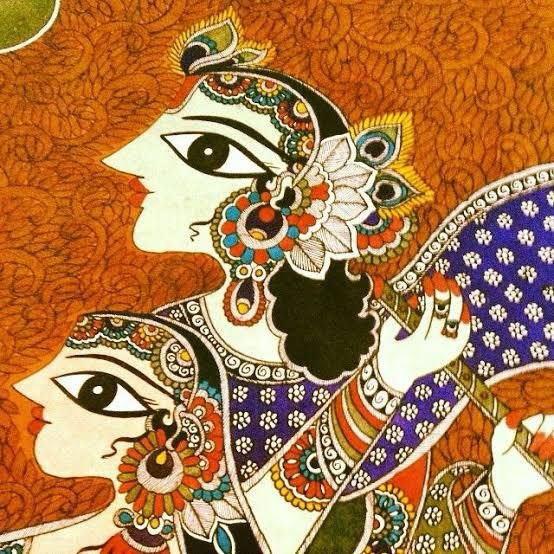
Techniques and Styles
Madhubani paintings are known for their distinctive style, marked by intricate patterns, bold outlines, and vivid colors. Artists traditionally use natural pigments and dyes derived from plants, minerals, and other organic sources. For instance, turmeric is used for yellow, indigo for blue, and kusum flower juice for red.
There are several styles within Madhubani painting, each with unique characteristics:
-
Bharni: Known for its use of vibrant colors and intricate detailing, Bharni paintings often depict scenes from Hindu mythology, particularly the lives of gods and goddesses like Krishna, Rama, and Durga.
-
Katchni: The Katchni style is characterized by delicate lines and minimal use of color. This style emphasizes fine, intricate patterns, often rendered in monochrome with a single color, such as black or red.
-
Tantrik: This style, often associated with tantric rituals, is symbolic and features esoteric figures and symbols representing spiritual themes.
-
Godna: Inspired by the tattoo art of the Mithila region, Godna style incorporates patterns and designs that mimic traditional tattooing techniques. These paintings are typically monochromatic, using black as the primary color.
-
Kohbar: Traditionally used in wedding rituals, the Kohbar style is rich with symbols of fertility and love, including lotus flowers, bamboo groves, fish, birds, and snakes.
Evolution and Global Recognition
Originally painted on walls, Madhubani art has evolved to include paper, canvas, cloth, and other mediums. This evolution has helped the art form gain international recognition, with Madhubani paintings now exhibited in galleries and museums worldwide.
The government of India and various NGOs have played pivotal roles in promoting Madhubani art, providing artists with platforms to showcase their work nationally and internationally. Today, Madhubani artists are celebrated for their exceptional skills and creativity on a global stage.
The Role of Women in Madhubani Art
Women have always been the backbone of Madhubani painting, preserving and nurturing this art form for centuries. For many women in Mithila, painting is not only a form of artistic expression but also a means of economic empowerment. Through their art, they have gained financial independence and supported their families.
In recent years, many Madhubani artists, especially women, have gained national and international recognition. The success of artists like Sita Devi, Mahasundari Devi, and Baua Devi has inspired a new generation to continue this rich tradition.
Madhubani Painting: A Timeless Art Form from the Heart of Bihar
Madhubani painting, also known as Mithila painting, is one of India’s most cherished art forms, originating from the culturally vibrant Mithilanchal region, which spans parts of Bihar and Nepal. With roots tracing back to ancient times, Madhubani painting is more than just an art form; it is a tradition of storytelling passed down through generations. This art form, renowned for its bold colors, intricate designs, and deep cultural significance, has captivated art enthusiasts worldwide.
Origins of Madhubani Painting
The history of Madhubani painting is as colorful as the art itself. According to legend, the origins of this art form date back to the time of the Ramayana, when King Janaka of Mithila commissioned artists to create paintings to commemorate the wedding of his daughter, Sita, to Lord Rama. These artworks, originally painted on the walls of homes, depicted scenes from mythology, nature, and daily life.
Traditionally, Madhubani paintings were created by women on the walls of their homes and in courtyards as part of religious rituals and during special occasions like weddings and festivals. This practice was passed down from mother to daughter, ensuring the continuity of this ancient tradition.
Themes and Symbolism
Religious Themes:
Many Madhubani paintings depict scenes from Hindu epics like the Ramayana and Mahabharata or feature deities such as Krishna, Shiva, and Durga. These paintings are often created during festivals and religious ceremonies.
Nature:
Nature is central in Madhubani art, with trees, flowers, animals, and birds frequently appearing in the paintings. Common motifs include the sun, moon, and sacred plants like tulsi, symbolizing life, growth, and harmony.
Social, Cultural, and Feminine Themes:
Madhubani artists often depict scenes from daily life, such as village activities, marriages, and festivals, offering a glimpse into the social and cultural fabric of the Mithila region. A recurring theme in these paintings is the portrayal of feminine energy, with women depicted as powerful and nurturing figures, embodying various forms of the goddess. These representations highlight the integral role of women in both the art and the culture of Mithila, reflecting their strength, resilience, and spiritual significance.
Madhubani Painting in Contemporary Times
Madhubani painting has transcended its traditional roots and found a place in contemporary art and design. It is now used in various forms, from paintings to home décor, fashion, and digital media. The intricate designs have inspired clothing, accessories, and home furnishings, making it popular among art lovers and fashion enthusiasts alike.
However, the commercialization of Madhubani art has raised concerns about preserving its authenticity and traditional techniques. Many artists and organizations are working to ensure that while the art form evolves, it retains its cultural essence.

